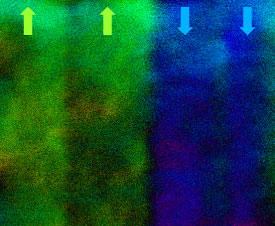

05/28/2018

Reprinted, with permission, from Ref. 1. Copyright 2018 American Chemical Society.
By employing the latest electron microscopy techniques and calculation methods, AIMR researchers have shed new light on magnetite, a magnetic material known since antiquity1. Specifically, they have shown that the magnetism at crystal boundaries in magnetite depends on the arrangement of atoms close to the boundary — an important finding that will inform the development of advanced magnetic devices.
Many magnetic materials are mosaics of small crystals whose magnetism points in different directions. A classic example is magnetite (Fe3O4), the oldest known magnetic material. Material scientists have long wondered how the arrangement of atoms at the boundaries between these crystals relates to the crystals’ magnetism, but it has been technically challenging to simultaneously and accurately determine both aspects.
Now, Chunlin Chen of the AIMR at Tohoku University and his co-workers have succeeded in doing this in magnetite by using state-of-the-art scanning transmission electron microscopy with differential phase contrast imaging to measure the electric and magnetic fields in the material. They also employed first-principles calculations.
The team, led by Yuichi Ikuhara, looked at a special kind of boundary between crystals in magnetite in which the atoms on one side of the boundary are a mirror image of those on the other side. They found that the magnetism in the crystals on either side of this ‘twin boundary’ can be either parallel (ferromagnetic) or anti-parallel (antiferromagnetic; see image), depending on the arrangement of atoms close to the boundary.
This was an unexpected discovery. “We were surprised to find that the magnetic coupling of twin boundaries depends only on the atomic core structures and resulting electronic structures within a few atomic layers of the boundary,” says Chen. “We had previously thought that atoms far from the interface might also play an important role.”
The finding is a significant one for the field. “Establishing the one-to-one correspondence between the atomic structure and magnetic coupling across individual boundaries has been long desired in the field of magnetism and magnetic materials,” notes Chen.
This insight will be valuable for practical applications, Chen says. “This tells us that we can tailor the magnetic properties of multilayer magnetic films by manipulating their interfacial microstructures, which will facilitate the development of high-performance devices.”
The team now hopes to establish a general rule for the interaction between the atomic and electronic structures of magnetic materials and the magnetic properties of their grain boundaries by systematically investigating the magnetic couplings across other types of grain boundaries in magnetite.
This research highlight has been approved by the authors of the original article and all information and data contained within has been provided by said authors.